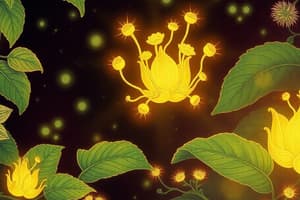Podcast
Questions and Answers
What is photosynthesis?
What is photosynthesis?
This is a process where the energy from sunlight is used to make glucose.
Where does photosynthesis occur?
Where does photosynthesis occur?
Photosynthesis occurs in the chloroplast.
What are chloroplasts and where are they found?
What are chloroplasts and where are they found?
Chloroplasts are green plant organelles that are used to make food and store food energy.
What are the two main functions of chloroplasts?
What are the two main functions of chloroplasts?
Why do most leaves appear green?
Why do most leaves appear green?
What is the primary pigment found in chloroplasts?
What is the primary pigment found in chloroplasts?
What is the formula for photosynthesis?
What is the formula for photosynthesis?
What three things are used to make glucose in photosynthesis?
What three things are used to make glucose in photosynthesis?
What is produced in photosynthesis?
What is produced in photosynthesis?
What is the glucose used for?
What is the glucose used for?
What process happens in the mitochondria?
What process happens in the mitochondria?
What does cell respiration create?
What does cell respiration create?
What happens to carbohydrates during cellular respiration?
What happens to carbohydrates during cellular respiration?
What is the chemical energy in the cell called?
What is the chemical energy in the cell called?
What is a product of cellular respiration?
What is a product of cellular respiration?
How many parts does photosynthesis have?
How many parts does photosynthesis have?
What does photosynthesis require?
What does photosynthesis require?
What are pigments?
What are pigments?
What is chlorophyll?
What is chlorophyll?
What is glycolysis?
What is glycolysis?
What does glycolysis begin with?
What does glycolysis begin with?
What does aerobic mean?
What does aerobic mean?
What does anaerobic mean?
What does anaerobic mean?
In the presence of O2, how many molecules of ATP can a cell produce per glucose molecule?
In the presence of O2, how many molecules of ATP can a cell produce per glucose molecule?
Calories are defined as what?
Calories are defined as what?
Flashcards are hidden until you start studying
Study Notes
Photosynthesis Overview
- Photosynthesis utilizes sunlight to convert carbon dioxide and water into glucose and oxygen.
- Occurs in chloroplasts, specialized organelles in plant cells.
Chloroplasts
- Chloroplasts are green organelles that produce and store food energy.
- Function: food production and energy storage.
- Contain chlorophyll, the primary pigment that captures light energy.
Pigments and Light
- Chlorophyll reflects green light, making most leaves appear green.
- Chloroplasts contain thylakoids, structures arranged in stacks called grana, which are crucial for photosynthesis.
Photosynthesis Process
- Formula: CO2 + H2O + sunlight → C6H12O6 + O2.
- Requires three main ingredients: carbon dioxide, water, and sunlight.
- Light-dependent reactions occur in thylakoid membranes; the Calvin Cycle (light-independent) occurs in the stroma.
Cellular Respiration
- Occurs in mitochondria, breaking down glucose to release energy.
- Formula: C6H12O6 + 6O2 → 6H2O + 6CO2 + energy.
- Produces adenosine triphosphate (ATP), the cell's chemical energy.
Energy Conversion
- Glycolysis initiates cellular respiration, breaking down glucose in the cytoplasm and yielding a small amount of energy (2 ATP).
- Aerobic respiration produces up to 36 ATP in the presence of oxygen; more efficient than anaerobic processes.
- Anaerobic respiration includes alcoholic and lactic acid fermentation, occurring without oxygen and yielding less energy.
Energy Measurement
- A calorie is defined as the required energy to raise the temperature of 1g of water by 1°C.
Key Processes
- Glycolysis leads to the release of energy from glucose.
- The Krebs Cycle and Electron Transport Chain are parts of aerobic respiration in mitochondria.
Summary of Key Differences
- Photosynthesis captures energy; cellular respiration releases energy.
- Photosynthesis occurs in chloroplasts; cellular respiration takes place in mitochondria.
Studying That Suits You
Use AI to generate personalized quizzes and flashcards to suit your learning preferences.




